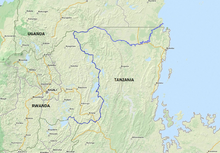The Kagera River, also known as Akagera River, or Alexandra Nile, is an East African river, forming part of the upper headwaters of the Nile and carrying water from its most distant source.[1]: 167 With a total length of 597 km (371 mi) from its source located in Lake Rweru in Rwanda.
| Kagera Akagera | |
|---|---|
 The confluence of the Kagera and Ruvubu rivers near Rusumo Falls, Rwanda/Tanzania. | |
 Map of the Kagera River flowing into Lake Victoria. | |
| Location | |
| Country | Burundi |
| Country | Rwanda |
| Country | Tanzania |
| Region | Kagera Region |
| Country | Uganda |
| Physical characteristics | |
| Source | |
| • coordinates | 2°21′18″S 30°22′22″E / 2.35500°S 30.37278°E |
| Source confluence | near Lake Tanganyika |
| • location | Eastern Province, Rwanda |
| Mouth | |
• location | Lake Victoria |
• coordinates | 0°56′41″S 31°46′36″E / 0.94472°S 31.77667°E |
| Length | 597 km (371 mi) |
| Basin size | 59,700 km2 (23,100 sq mi) |
| Discharge | |
| • average | 184 m3/s (6,500 cu ft/s) |
| • maximum | 540 m3/s (19,000 cu ft/s) |
| Basin features | |
| Tributaries | |
| • left | Nyabarongo River |
| • right | Ruvuvu River |
The section of river named Kagera begins in Burundi, flowing out from Lake Rweru. From the lake, it flows east along the Rwanda-Burundi and Rwanda-Tanzania borders to a confluence with the Ruvubu River. The waters of the Kagera are thus provided by two major tributaries, the Nyabarongo of Rwanda, which feeds Lake Rweru, and the Ruvubu of Burundi. It is unknown which of these two feeder rivers is the longer and hence the ultimate source of the Nile. From the confluence, the Kagera flows north along the Rwanda-Tanzania border, over Rusumo Falls and through Akagera National Park. It then takes a turn to the east, following the Tanzania-Uganda border and emptying into Lake Victoria in Uganda. In 1898, Richard Kandt was the first European to reach the source of the Kagera.[2]
The river has featured prominently in the histories of the countries it runs through, particularly Rwanda. In 1894, German Gustav Adolf von Götzen crossed the Kagera at Rusumo Falls, marking the Rwandan colonial era that officially started in 1899. And in 1916, during World War I, the Belgians defeated the Germans, entering Rwanda by the same route. The river gained international notoriety in 1994 for carrying bodies from the Rwandan genocide into Lake Victoria, causing a state of emergency to be declared in areas of Uganda, where these bodies eventually washed up.
Geography edit
The Kagera rises in Burundi and flows into Lake Victoria. It is the largest single inflow into the lake, contributing approximately 6.4 billion cubic metres of water a year (about 28 per cent of the lake's outflow).[3] The Kagera is formed by the confluence of the Ruvuvu and the Nyabarongo, close to the northernmost point of Lake Tanganyika.[4] It forms parts of the Burundi–Tanzania, Rwanda–Tanzania, Burundi–Rwanda, and Tanzania–Uganda borders. It lends its name to Akagera National Park in northern Rwanda, as well as to the Kagera Region of Tanzania. On the river are the Rusumo Falls, an important crossing point between Rwanda and Tanzania. It is near the town of Rusumo.
Fish edit
The Kagera River basin is rich in fish. As of 2001[update], there were at least 55 species known from the Rwandan section alone and the actual number is likely higher.[5] Additionally, there are at least 15 undescribed species of haplochromine cichlids that are endemic to some of the lakes in the upper parts of the river basin.[6] Because of the many waterfalls and rapids, the various sections of the Kagera River basin are clearly separated, making movements by fish between them difficult or even impossible.[5][7]
Genocide edit
During the Rwandan genocide of 1994, the Kagera was used to dispose of corpses as thousands of Tutsis and Hutu political moderates were murdered on the river banks.[8] The river brought the massacred bodies into Lake Victoria, creating a serious health hazard in Uganda.[9]
See also edit
- Ruvuvu River - Right tributary of the river
- Nyabarongo River - Left tributary of the river
References edit
Notes edit
- ^ Stanley, H.M., 1899, Through the Dark Continent, London: G. Newnes, ISBN 0486256677
- ^ "Archived copy" (PDF). Archived (PDF) from the original on 2016-03-04. Retrieved 2019-09-21.
{{cite web}}: CS1 maint: archived copy as title (link) - ^ Rangeley, p. 54
- ^ Dumont, p. 341
- ^ a b De Vos, L; J. Snoeks; D.T. van den Audenaerde (2001). "An Annotated Checklist of the Fishes of Rwanda (East Central Africa), With Historical Data on Introductions of Commercially Important Species". Journal of East African Natural History. 90 (1): 41–68. doi:10.2982/0012-8317(2001)90[41:AACOTF]2.0.CO;2.
- ^ Sayer, C.A.; L. Máiz-Tomé; W.R.T. Darwall (2018). Freshwater biodiversity in the Lake Victoria Basin: Guidance for species conservation, site protection, climate resilience and sustainable livelihoods. Cambridge, UK and Gland, Switzerland: IUCN. doi:10.2305/IUCN.CH.2018.RA.2.en. ISBN 9782831718965.
- ^ Berakhi, Robel Ogbaghebriel; Oyana, Tonny J.; Adu-Prah, Samuel (2014-05-23). "Land use and land cover change and its implications in Kagera river basin, East Africa". African Geographical Review. 34 (3): 209–231. doi:10.1080/19376812.2014.912140. ISSN 1937-6812. S2CID 153931262.
- ^ January, p. 83
- ^ Lorch, Donatella (21 May 1994), "Thousands of Rwanda Dead Wash Down to Lake Victoria", The New York Times, archived from the original on 17 March 2013, retrieved 26 February 2010
Sources edit
- Dumont, Henri J. (2009). The Nile: Origin, Environments, Limnology and Human Use. Springer. ISBN 978-1-4020-9725-6.
- January, Brendan (2007). Genocide: modern crimes against humanity. Twenty-First Century Books. p. 83. ISBN 978-0-7613-3421-7.
- Rangeley, Robert (1994). International river basin organizations in sub-Saharan Africa. World Bank Publications. ISBN 0-8213-2871-9.
External links edit
- . Encyclopædia Britannica (11th ed.). 1911.